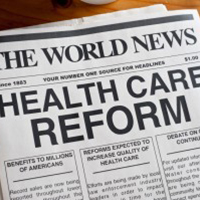The Expiration of the Public Health Emergency Also Ends Policies to Lower Health Access Barriers

By Emma Walsh-Alker and Megan Houston
On January 31, 2020, the federal government instituted a “public health emergency” (PHE) in response to COVID-19. The U.S. Department of Health & Human Services (HHS) has renewed this declaration eight times in the past two years, and although it is set to expire on April 16, it is widely expected that HHS will renew it at least once more. Concurrently, federal agencies have issued, and Congress has enacted, several COVID relief bills that authorize funding and programs tied to the status of the PHE. Most of the focus has rightfully been placed on one of the most impactful policies, which requires states to pause eligibility redeterminations for Medicaid enrollees for the duration of the pandemic, in exchange for enhanced federal funding. Separately, CHIR has highlighted states’ daunting task of processing redeterminations for an estimated 86 million people and limiting coverage losses. But Medicaid is not the only program affected by pandemic relief policies that expire at the end of the PHE. Additional policies mandate coverage of COVID-19 tests and related care, lower barriers to telehealth, and ease the use of mental health and substance use services.* An abrupt end to these policies could have a significant impact on consumers’ ability to afford and access these services.
Access to COVID-19 Related Services
Mandates to Cover and Waive Cost-Sharing for COVID-19 Tests
The Coronavirus Aid, Relief, and Economic Security Act (CARES Act) requires insurers to cover COVID-19 testing and vaccination administration without imposing cost sharing on plan members until the end of the PHE. Given the unpredictability of the virus’s evolution and predictions of another COVID-19 wave, testing continues to be a critical tool to monitor and limit spread, and insurance coverage is crucial to consumer testing access.
Insurers are likely to reimpose deductibles and copayments for testing services once the PHE ends, increasing the cost to consumers. In general, when consumers face cost-sharing for health care services, they use fewer services. In the case of COVID-19 testing, this could have significant public health implications if there is another surge of the virus.
Broad Coverage of COVID-19 Vaccinations
The requirement for insurers to cover vaccine administration without regard for provider network participation is another policy tied to the PHE. The challenge to motivate reluctant Americans to get vaccinated against COVID-19 has been well documented; adding potential out-of-pocket costs will likely not send vaccine-hesitant individuals running out to get the shot.
Telehealth and Other New Care Delivery Models
Increased Flexibility for Provision of Telehealth
At the beginning of the pandemic, HHS took several actions to increase access to telehealth. The agency adjusted rules for Medicare and Medicaid to allow providers to deliver care across state lines, waived some privacy and security requirements, and permitted reimbursement for telephone-based appointments. A recent report from HHS’s Office of Inspector General (OIG) found telehealth to be a critical source of care for Medicare beneficiaries during the last two years; nearly 30 million beneficiaries used telehealth during the first year of the pandemic, approximately two in five beneficiaries. Last month, Congress extended certain telehealth flexibilities for 151 days beyond the end of the PHE and directed the Medicare Payment Advisory Committee (MedPAC) and the HHS Office of Inspector General to issue a report with cost and utilization implications. The extension will allow Medicare beneficiaries to continue to access telehealth at home, from out-of-state providers and with audio-only options. Lawmakers are balancing the value these flexibilities provide for beneficiaries with concerns about telehealth’s impact on cost and potential for fraud.
Flexibility for Provision of Care at Home
HHS also gave hospitals new flexibility to deliver acute-level services to Medicare beneficiaries in their homes. Hospital systems and provider groups are pushing for Congress to extend this policy beyond the end of the PHE, with providers highlighting the ability of this care delivery model to help resolve underlying health issues and free up space in hospitals. While originally intended as an emergency response for hospitals that were at capacity with COVID-19 patients, the policy has shown promise in its ability to save money and is popular among patients.
Flexibilities for Mental Health and Substance Use Disorder Treatment
As mental health care needs spiked during the pandemic, our care delivery systems for mental health and substance use disorders have largely failed to meet the need. Building on the telehealth flexibilities described above, the administration relaxed in-person requirements for patients seeking mental health and substance use treatment, particularly for patients with opioid use disorder (OUD). Since the PHE declaration, the Drug Enforcement Administration (DEA) and Substance Abuse and Mental Health Services Administration (SAMHSA) released several new rules impacting insurers, providers, and patients—all of which are set to expire with the PHE absent action to extend the policies.
First, providers registered with the DEA were permitted to prescribe schedule II-V controlled substances to new patients without an in-person evaluation. SAMHSA has also allowed providers to prescribe patients longer supplies of take-home methadone doses, and the DEA authorized registered Opioid Treatment Programs (OTPs) to operate mobile methadone vans without having to obtain separate registration for each van as previously required.
Before the pandemic, many public health and policy experts asserted regulation of OUD treatment has been unnecessarily stringent. A 2019 National Academies of Sciences, Engineering, and Medicine report found that safe and effective medications for OUD like buprenorphine and methadone are widely under-utilized due in large part to lack of access to affordable treatment, fragmented health care delivery systems, stigma surrounding substance use disorder treatment, and burdensome regulations. People of color disproportionately face barriers in initiating and maintaining treatment. Preliminary research shows that many patients with OUD reported positive experiences and increased adherence to their treatment plans under the PHE guidelines. SAMHSA has said it plans to extend the relaxed restrictions on take-home methadone doses another year, regardless of the PHE ending. Additionally, if signed into law, the Opioid Treatment Access Act introduced in Congress in February would codify and expand on PHE flexibilities.
Worth Keeping? Policymakers Should Assess the Benefits of Maintaining Federal Policies to Expand Health Care Access during the PHE
The federal government provided tools to improve affordability and access for patients during the pandemic. Many provisions have proven to be valuable beyond the context of COVID-19, reducing barriers to health care services and giving providers new flexibilities to meet patients’ needs. Although public health precautions have been lifted across the country, COVID-19 is likely to be with us well beyond the end of the PHE, requiring a continuation of many public health measures, including testing, to keep the virus at bay. The looming PHE expiration should prompt federal policymakers to assess the costs and benefits of these policies, potentially serving as a catalyst for more permanent reform.
*This blog is not intended to cover every COVID-19 relief program, policy, or flexibility that will sunset when PHE ends, but highlights a few health insurance-related initiatives that are particularly relevant to accessible and affordable care.







